AdGuard DNS 2.0 : un contrôle inouï de votre trafic
Aujourd'hui, nous lançons AdGuard DNS 2.0. C'est un grand moment pour nous, vers lequel nous nous dirigions sans relâche depuis 2016. Beaucoup de choses se sont passées pendant ce temps - et j'ai tellement de choses à vous raconter. Suivons le chemin parcouru par AdGuard DNS, d'un projet expérimental à moitié cuit à un produit à part entière avec plus de 50 serveurs dans plus de 15 sites.
L'histoire
C'est difficile à croire, mais le 26 juillet, AdGuard DNS aura 6 ans. Il est apparu à un moment où les versions d'AdGuard pour toutes les principales plateformes avaient déjà été publiées et où nous essayions de trouver comment protéger des publicités et des trackers les appareils sur lesquels AdGuard ne pouvait pas être installé. C'est alors que nous avons eu l'idée de créer un service DNS comme moyen de passer au niveau supérieur.
AdGuard DNS est né comme un projet complètement expérimental sur lequel nous n'avions pas prévu de dépenser beaucoup d'efforts. La première version d'AdGuard DNS a été écrite en Java, en utilisant les développements existants d'AdGuard pour Android. Il ne nous a fallu que deux ou trois semaines pour tout faire du début à la fin, publier l'annonce et lancer le service.
Les problèmes ne se sont pas fait attendre. Après tout, vous ne pouvez pas prendre deux semaines et faire un service de haute qualité. Une tâche qui semblait très simple à première vue s'est avérée beaucoup, beaucoup plus difficile en réalité. Et plus le nombre d'utilisateurs augmentait, plus il devenait évident que tout ce que nous faisions devait être jeté et refait.
Je n'oublierai jamais une nuit où, alors que je prenais le train pour me rendre dans ma ville natale pour visiter mes parents, AdGuard DNS a cessé de gérer la charge à cause du trop grand nombre d'utilisateurs. J'ai essayé frénétiquement d'arranger la situation, mais je ne pouvais presque rien faire à cause de la mauvaise qualité de la connexion. Ce fut probablement la plus longue interruption de service DNS d'AdGuard. Mais cela nous a aidé à prendre la décision de réécrire complètement le service et de le prendre beaucoup plus au sérieux.
AdGuard DNS 1.0
Nous avons changé la technologie et l'approche de mise en œuvre. Réécrit en Go, AdGuard DNS a gagné la capacité de gérer une charge élevée et de travailler avec des serveurs géographiquement dispersés dans le monde entier. Et, bien sûr, il prend en charge tous les protocoles DNS connus avec un cryptage prêt à l'emploi. Cela a abouti à la version officielle d'AdGuard DNS (avant cela, le service était techniquement en version bêta).
Le "sous-produit" le plus important de notre travail pendant cette période a été AdGuard Home, un serveur DNS de blocage et de suivi des publicités au niveau du réseau basé sur les mêmes technologies que AdGuard DNS. Après avoir surmonté tous les défis de la mise en place d'AdGuard Home, l'utilisateur a le contrôle total du réseau et de tous ses appareils sans installer aucune application cliente, et peut également gérer le processus de filtrage via l'interface web.
Fait intéressant : fin 2019 AdGuard DNS traitait environ 27K requêtes par seconde, dont seulement un tiers provenait de protocoles chiffrés (DoH, DoT).
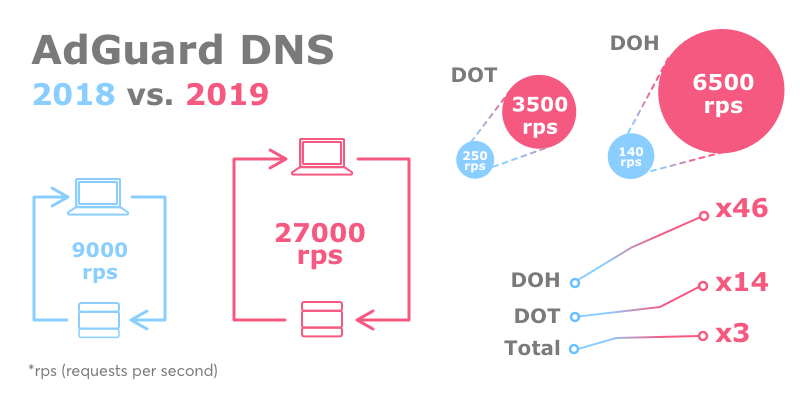
En 2022, la situation avait radicalement changé. Aujourd'hui, AdGuard DNS traite environ un million de demandes par seconde, et plus de 90 % de ces demandes sont cryptées. Cela représente une 37 augmentation de charge en deux ans et demi (en réalité, le chiffre est encore plus élevé, car les protocoles cryptés sont beaucoup plus "lourds" que les DNS ordinaires).
D'un côté, c'est formidable ! AdGuard DNS est devenu l'un des résolveurs DNS publics les plus populaires au monde. Mais d'un autre côté, un service d'une telle envergure ne peut plus fonctionner dans l'ancien mode "expérimental". Alors, qu'avons-nous décidé ? Bien sûr, de tout retravailler !
Voici AdGuard DNS 2.0
Que manquait-il à l'ancienne version d'AdGuard DNS ? C'était un service "installez et oubliez", en d'autres termes, il ne vous permettait pas de gérer le blocage. C'était suffisant pour certaines personnes. Mais en regardant les utilisateurs d'AdGuard Home, nous savions que beaucoup voulaient contrôler les requêtes et décider eux-mêmes ce qui sera bloqué sur leurs appareils et comment.
Avec la sortie d'AdGuard DNS 2.0, tout cela est maintenant possible - et disponible dans AdGuard DNS privé. Il combine la simplicité de la configuration avec de nombreuses fonctionnalités utiles qui vous permettent de voir et de contrôler toutes les demandes provenant de vos appareils, de personnaliser le blocage à votre convenance et de profiter du service.
Gestion du blocage des domaines
Activez les listes de blocage dont vous avez besoin et désactivez celles qui ne sont pas nécessaires, bloquez les sites via le journal des requêtes, ajoutez vos propres règles de filtrage DNS aux règles utilisateur (une à la fois ou sous forme de liste) - configurez AdGuard DNS 2.0 pour ne bloquer que ce dont vous avez besoin.
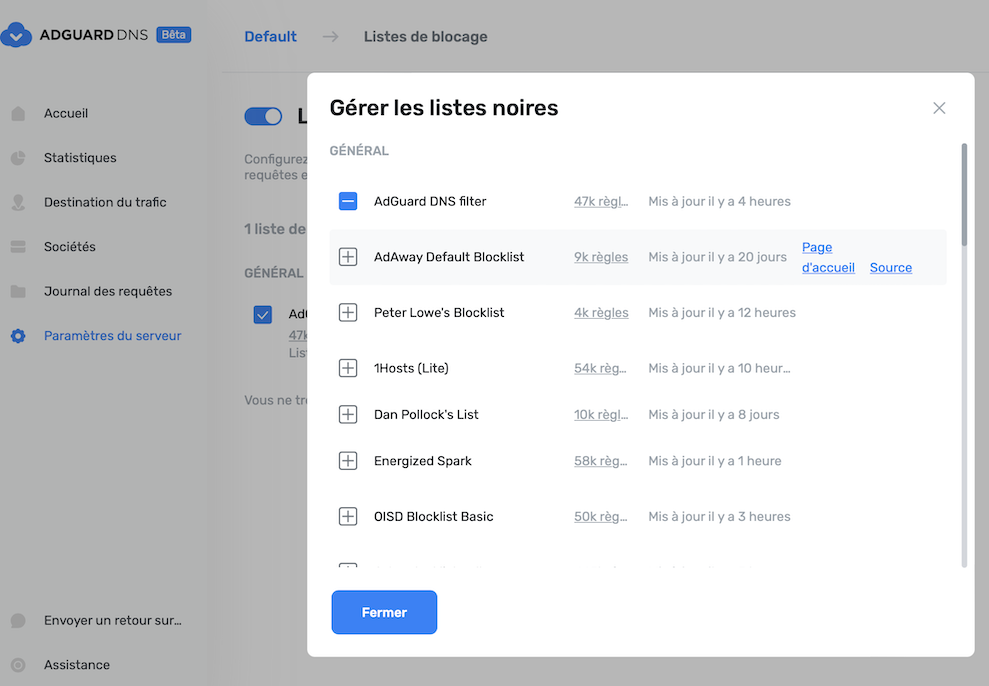
Journal des requêtes
C'est dans cette section que tout se dévoile ! Ici, vous avez chaque requête sous les yeux : quel appareil l'a envoyée, à quelle heure, vers quel pays, et à quelle société appartient le serveur de destination. De plus, dans le journal des requêtes, vous pouvez voir comment AdGuard DNS 2.0 a traité la requête : bloquée, modifiée ou traitée.

Nous l'avons déjà dit, mais nous le répétons : directement dans le journal des requêtes, vous pouvez bloquer des domaines ou passer outre le blocage et créer vos propres règles.
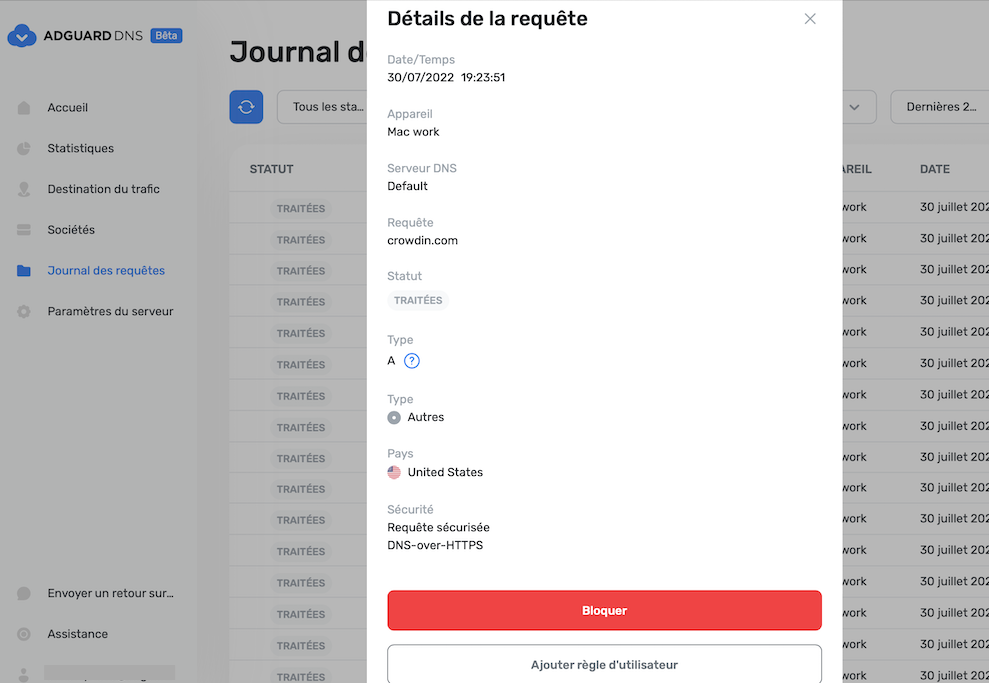
Statistiques avancées
Le nombre total et la géographie des demandes, le nombre de demandes bloquées et la liste des entreprises auxquelles les demandes ont été adressées - tout cela est visible à la fois dans le tableau récapitulatif et dans des onglets séparés contenant des informations statistiques détaillées.
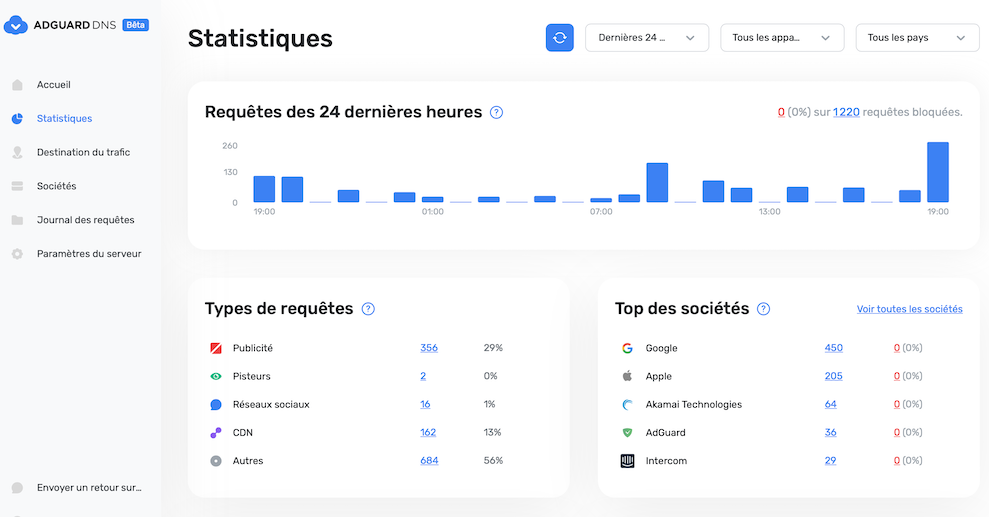
Contrôle parental
Pour protéger votre enfant des contenus en ligne que vous jugez inappropriés, configurez et activez l'option Contrôle parental. Outre les fonctions telles que le blocage des sites web pour adultes et la recherche sécurisée, nous avons ajouté la possibilité de spécifier manuellement les domaines à bloquer et de définir un calendrier selon lequel le contrôle parental fonctionnera.
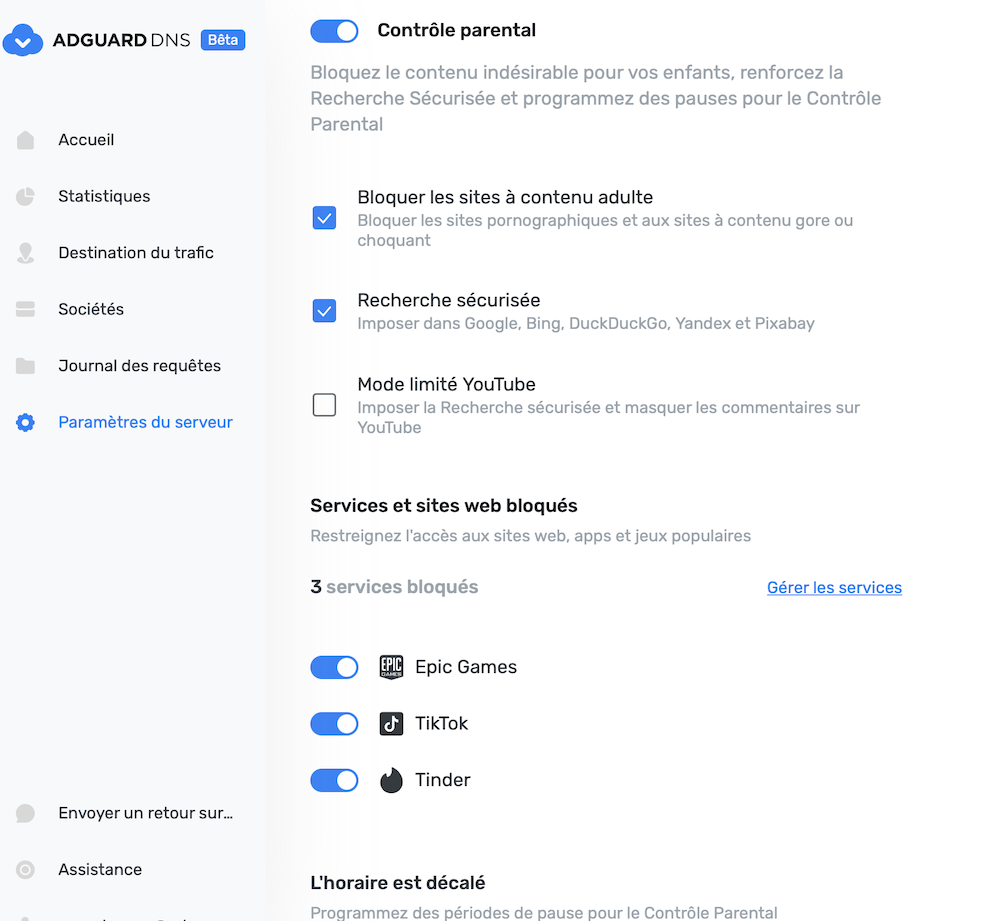
Thème sombre
Comme beaucoup d'entre vous, nous pensons que le thème sombre est une fonctionnalité importante. C'est pourquoi il est inclus dans AdGuard DNS 2.0, ainsi que dans la grande majorité de nos autres produits.
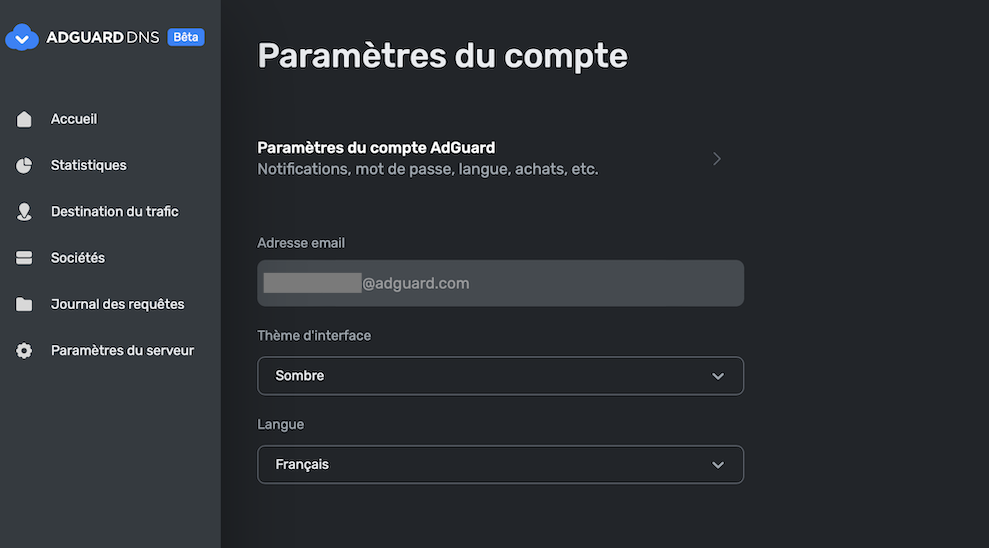
Pour en savoir plus sur le service et ses fonctionnalités, faites une petite visite en ligne avec Dayane, la mascotte de AdGuard DNS.
Ce n'est pas tout
Nous avons beaucoup de projets pour l'avenir, mais nous ne les avons pas encore mis en œuvre.
- Une meilleure intégration avec AdGuard VPN. Vous pouvez déjà utiliser AdGuard DNS avec VPN sur Android, Windows et Mac, bientôt nous ajouterons iOS à cette liste.
- L'intégration avec AdGuard Home est également prévue pour l'avenir.
- Nous ne voulons pas nous arrêter au DNS. L'objectif final est de rendre les bloqueurs de contenu traditionnels superflus (oui, cela signifie rendre AdGuard superflu aussi). Il s'agit bien sûr d'un objectif à long terme, mais pour l'atteindre, il faut plus que des DNS.
Types d'abonnements
On s'empresse de vous rassurer : le DNS public AdGuard ne va pas disparaître, vous pouvez toujours l'utiliser gratuitement. Mais si vous voulez tous les avantages du DNS privé d'AdGuard, vous devez choisir l'un des quatre abonnements :
Starter – un abonnement gratuit conçu pour vous permettre de vous familiariser avec le service. L'abonnement Starter n'implique pas de support technique et est limité à 300K requêtes par mois, 5 appareils et 2 serveurs.
Personnel – un abonnement conçu pour vous protéger, vous et votre famille. Vous bénéficiez de 10 millions de requêtes par mois, de 20 appareils et de 5 serveurs, ainsi que d'une assistance technique. Et si vous avez un abonnement VPN AdGuard, vous obtiendrez un abonnement DNS AdGuard personnel gratuit.
Équipe – un abonnement qui peut être conseillé aux propriétaires de petites entreprises. Il comprend 100 millions de requêtes par mois, 200 appareils, 50 serveurs et un support inclus.
Enterprise – abonnement pour les grandes entreprises : nombre illimité de demandes, de dispositifs et de serveurs, plus assistance prioritaire.

Vous pouvez choisir des frais mensuels ou annuels pour l'un des abonnements ci-dessus.
Conclusion
La sortie d'un nouveau produit est toujours un peu comme la soirée des Oscars. Pas dans le sens où quelqu'un va se faire frapper au visage, bien sûr. Je veux dire dans le sens de la distribution des remerciements. AdGuard DNS 2.0 est devenu possible non seulement grâce au travail de l'équipe de développement d'AdGuard, mais aussi grâce aux bêta-testeurs. Nous disons merci à tous ceux qui ont utilisé notre service dans les phases alpha et bêta, qui ont trouvé des bugs et les ont signalés. Nous n'aurions pas pu le faire sans vous.
Comme promis, nous organisons un tirage au sort pour ceux qui ont voulu être informés du lancement d'AdGuard DNS 2.0 et se sont inscrits sur la liste de diffusion. En jeu, 5 routeurs haut de gamme et 10 abonnements annuels personnels. Et en plus, tous ceux qui s'enregistreront sur le site web AdGuard DNS avant le 22 août recevront un abonnement Starter Plus automatiquement, valide jusqu'au 31 octobre.





















































